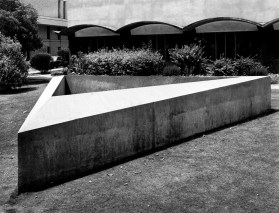Smog over Melbourne: Photo: Dean Flynn
This article by Shadow Minister for the Arts Martin Foley alleges the Napthine Government has failed the sector. Minister for the Arts Heidi Victoria defends the Government‘s record on the arts here.
While Tolstoy didn’t have the Victorian arts sector in mind when he wrote ‘All happy families are alike; each unhappy family is unhappy in its own way’ his words are an apt description of the current state of affairs.
The struggling members of the arts family – the independent and small companies, festivals, community arts organisations and culturally and artistically diverse groups across the State – are unhappy, and for good reason. They have been force fed cuts to grants and been shown a lack of respect for their contribution of our cultural present and future.
The apparently favoured ‘lead’ organisations hardly constitute a happy family branch. While enjoying the privilege of having their State Government contributions ‘locked in’ they confront the certainty of reduced real incomes compared to what they had previously received under triennial or annual funding levels before the 2011/2012 budget cuts.
The wise elders of the family in the State cultural agencies face governance uncertainty, reduced budgets, staff cuts and reductions in key areas of programs. Some have already struck hard times and thrown out family members and sold off the silverware.
Unifying all the disparate family groups of the Victorian Arts community is the bewilderment they share about what constitutes the Napthine Government’s policy on the role and purpose of the Arts. Despite crowing about the 40th anniversary of Arts Victoria, no one knows what guides the Napthine Government approach to the arts.
Despite promising to, the Governments refuses to set out a policy position for ‘a whole of government’ cultural framework within which arts and wider government, community and industry activity can be integrated’ and ‘a clear, fair and transparent processes to apply the limited resources in the sector in a transparent manner’.
The promise to develop a Victorian ‘cultural and arts strategy’ was made as part of its economic statement in late 2012. Consultations were promised. Expectations rose.
(This promise came after its botched ‘Organisations Investment Program’. A further reorganisation of funding under the Vic Arts Grant then followed.)
The evidence of the past three years demonstrates clearly why the Government doesn’t want such a policy. By not engaging with the community on how the arts fit into the fabric of Victorian society, the Government has deliberately created a smog of confusion and uncertainty to cover over their funding cuts. After all, if you articulate a clear vision then there’s a fair chance you will face calls to fund it. No vision – no plan – no grounds for a proper debate with the community about the arts means avoiding the arguments to fund it. Indeed the only thing that is clear, is that the Government’s views on ‘cultural development’ stop at the gates of the racetrack.
The lack of any framework also allows the Government to redirect scarce resources to their favourite causes whilst managing the decline of support for the wider creative arts community that drives creativity and innovation. This approach means the Government cal also avoid debates around difficult issues of increasing participation, quality and access.With it goes any idea in supporting the idea or role of the artist. This is closely followed by the inability to leverage other government and private sector investment support in a coherent manner to maximise the available limited funding dollars for the arts.
Instead we have the key cultural institutions directed to support the no doubt impressive mega White Night ‘event’, delivered not by Arts Victoria as a festival but by the Major Events Corporation and thus hidden away from accountability or scrutiny. We all like a party but is it a substitute for a cultural plan if it comes at the cost of diverting resources and focusing your investment in the CBD?
As we enter an election year the biggest issue facing creative communities big and small, established and emerging is can we sustain another year (or 5) of this policy free approach? Are we setting the scene for a combined Abbott/Napthine Tory ascendancy that sees a limited role for government in the arts and for arts in society?
Or is another approach that will position the role of the arts and cultural sectors at the heart of public policy, at the heart of about what it means to be part of a diverse, progressive, creative people? An approach that looks to what’s distinctive about ourselves and our place in the world and region for inspiration? An approach the recognises the importance of the artist, and the importance and arts and culture to the social and economic future of the State? The answer is yes. This is Labor’s approach.
In the meantime, the Victorian Government would be well advised that to heed Tolstoy’s other piece of advice: ‘Be bad, but at least don’t be a liar, a deceiver!’





